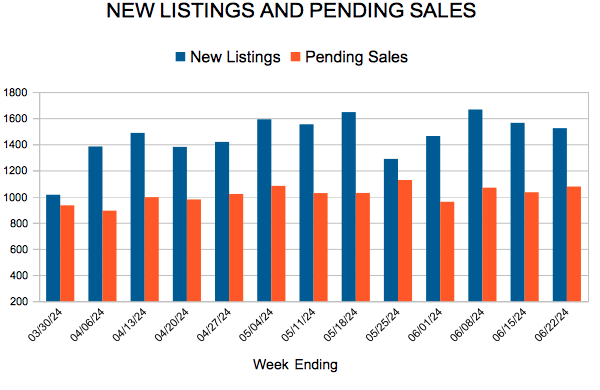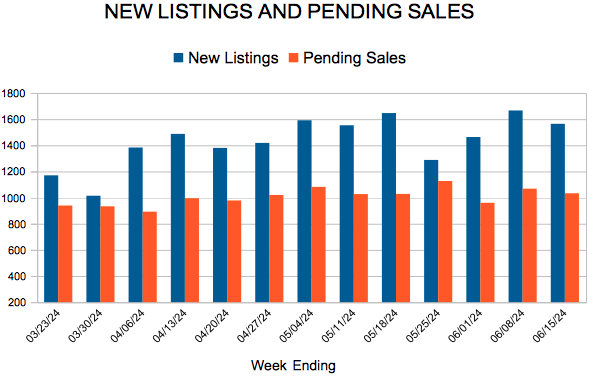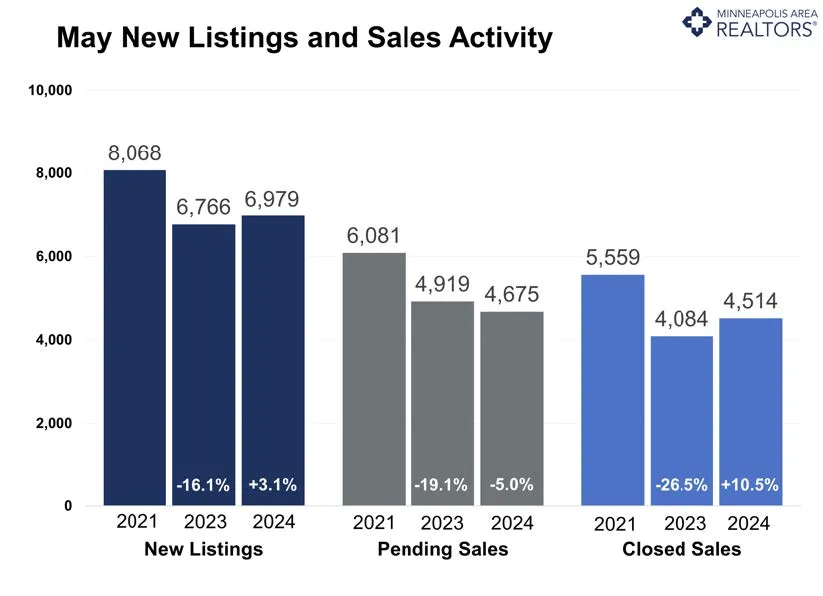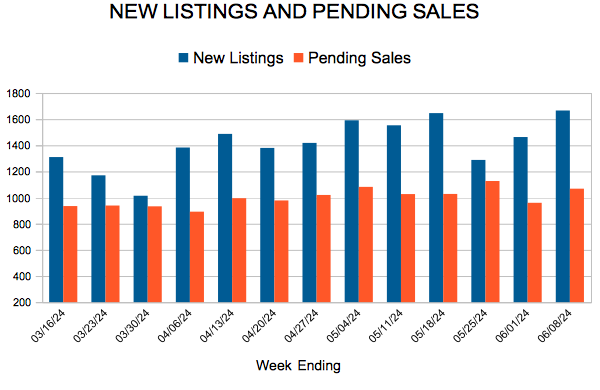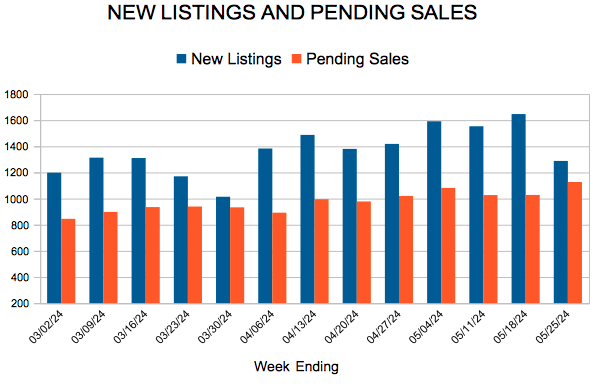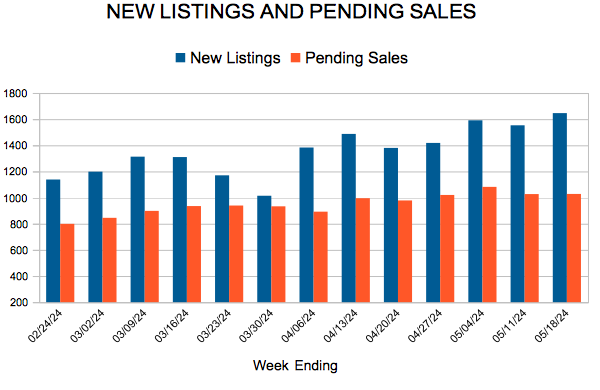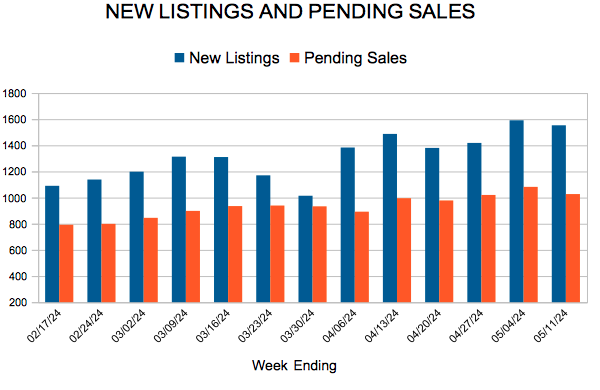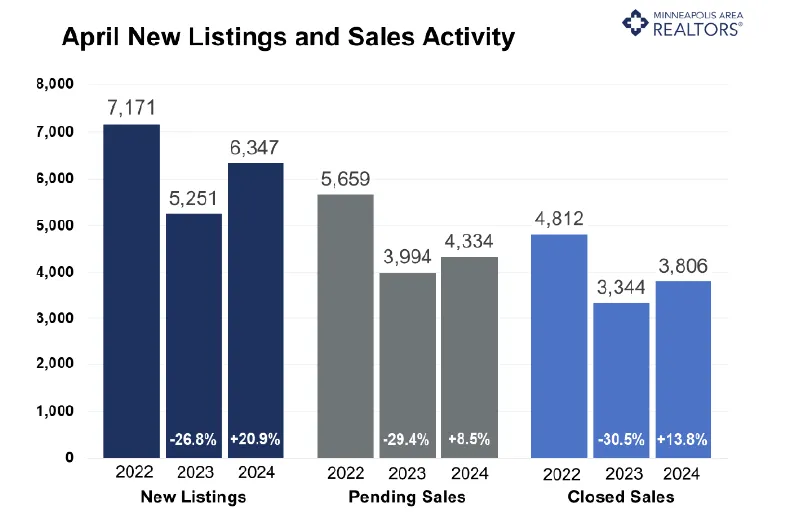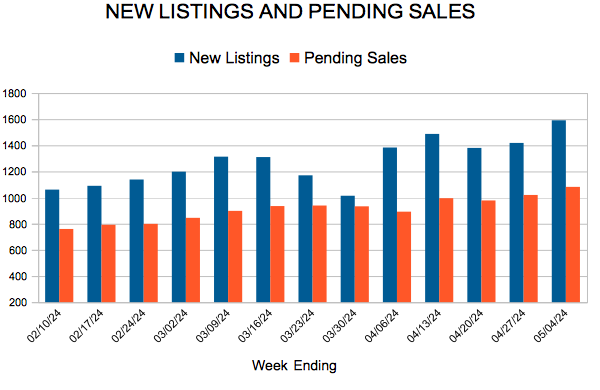New Listings and Pending Sales
May Housing Market Update
Growth in listings met by cooler demand leads to an increase in supply
- Signed purchase agreements fell 5.0%; new listings up 3.4%
- The median sales price increased 4.1% to $385,000
- Market times rose 7.2% to 40 days; inventory up 16.3% to 8,653
(Jun. 18, 2024) – According to new data from Minneapolis Area REALTORS® and the Saint Paul Area Association of REALTORS®, listings rose slightly compared to last year while sales softened. Inventory levels and prices were up.
Sellers, Buyers and Housing Supply
Buyers are starting to notice more inventory across the price spectrum. From under $200,00 to over $1,000,000, there are more homes for sale than there were a year ago. In fact, the number of homes for sale rose 15.7% from last year. That’s the highest number of active listings for May since 2020. And yet every price range—apart from $1,000,000 and above—remains a seller’s market where sellers are still getting strong offers relatively quickly. This year has seen growth in both listings and sales compared to 2023. For May, new listings are up 3.1% while sales fell 5.0%. One factor impacting May sales was higher than expected interest rates. Last May, rates were around 6.4% compared to 7.1% this year. Midyear is a good time to zoom out and look at some year-to-date figures. So far this year, seller activity is up 14.9% while buyer activity is up 5.3%.
A mix of stronger than expected economic data and continued inflation kept mortgage rates higher for longer and led financial markets to price in fewer rate cuts this year. But not everyone is feeling the benefits of the surprisingly resilient economy. Affordability remains a sticking point for would-be buyers—particularly first-time buyers without the equity from the last home to roll into the next. The typical monthly payment on the median-priced home is up over $1,000 since 2020.
There remains plenty of pent-up activity for both buyers and sellers. Even with the recent inventory gains, the market needs about 20,000 active listings to have a balanced market; currently there are fewer than 8,000. Buyers shopping the most affordable price points tend to be more rate-sensitive than luxury buyers who often use cash or have the financial wherewithal to simply absorb the higher payments. Some are able to skip the mortgage entirely by deploying cash. About 17.5% of Twin Cities homes are purchased in cash; it’s nearly double that for properties over $1 million.
Prices, Market Times and Negotiations
The median home price was up 4.1% to $385,000. Single family prices stood at $420,000, condo prices came in at $220,000 and townhomes checked in at $320,000. New home prices are just over $500,000 while existing home prices are $371,000. Even while they’re still in a relatively strong position, some sellers are finding themselves paying closing costs or incorporating other buyer incentives. “While the market is undergoing corrections, it is not a balanced market yet,” said Amy Peterson, President of the Saint Paul Area Association of REALTORS®. “Buyers need to remain both persistent and strategic ensuring their monthly payments align with their financial plans.”
Quality homes that show well in desirable areas are still getting multiple offers. Market-wide, sellers accepted offers at 100.1% of their list price, which was down from last year. Those purchase agreements were accepted after an average of 40 days on market, which was longer (slower) than last year. Every price point and area are unique. For example, single family homes are selling after 37 days but condos are taking 66 days. “While it’s true that each area and even market segment is unique, there are still some common threads,” said Jamar Hardy, President of Minneapolis Area REALTORS®. “Rising inventory is one of those themes, yet those shopping for homes shouldn’t assume we’re suddenly in a buyer’s market because we’re not.”
Location & Property Type
Since market activity always varies by area, price point and property type, housing markets shouldn’t be considered monolithic. Existing home sales performed better than new home sales. Single family sales fared better than condos or townhomes. Sales over $500,000 rose while sales under $500,000 softened. Cities such as Cambridge, New Richmond, Hugo and Buffalo saw among the largest sales gains while Arden Hills, Princeton, Medina and North Branch all had weaker demand. For cities with at least five sales, the highest priced areas were Wayzata, North Oaks, Excelsior and Mendota Heights. The most affordable areas were Norwood Young America, Albertville, Vadnais Heights and South St. Paul.
May 2024 Housing Takeaways (compared to a year ago)
- Sellers listed 6,979 properties on the market, a 3.1% increase from last May
- Buyers signed 4,675 purchase agreements, up 5.0% (4,514 closed sales, up 10.5%)
- Inventory levels increased 15.7% to 8,614 units
- Month’s Supply of Inventory rose 21.1% to 2.3 months (4-6 months is balanced)
- The Median Sales Price was up 4.1% to $385,000
- Days on Market was down 5.3% to 40 days, on average (median of 15 days, up 15.4%)
- Changes in Pending Sales activity varied by market segment and price point
- Single family sales fell 2.3%; condo sales were down 15.4%; townhouse sales decreased 10.2%
- Traditional sales were down 4.6%; foreclosure sales declined 12.5% to 42; short sales rose 25.0% to 10
- Previously owned sales decreased 3.8%; new construction sales were down 9.5%
- Sales under $500,000 declined 8.6%; sales over $500,000 increased 8.7%
New Listings and Pending Sales
New Listings and Pending Sales
New Listings and Pending Sales
New Listings and Pending Sales
New Listings and Pending Sales
April Housing Market Report
Listings are up more than sales meaning buyers are seeing more options
- Signed purchase agreements rose 8.5%; new listings up 20.9%
- The median sales price increased 4.1% to $385,250
- Market times fell 2.2% to 45 days; inventory up 14.1% to 7,705
(May 15, 2024) – According to new data from Minneapolis Area REALTORS® and the Saint Paul Area Association of REALTORS®, both listings and sales rose compared to last year at this time. Prices and inventory levels were also higher.
Sellers, Buyers and Housing Supply
(May 15, 2024) – According to new data from Minneapolis Area REALTORS® and the Saint Paul Area Association of REALTORS®, both listings and sales rose compared to last year at this time. Prices and inventory levels were also higher. Sellers, Buyers and Housing Supply May and June tend to be the busiest times of year for buying and selling homes. This year has seen growth in both listings and sales compared to 2023. Through April, seller activity is up 19.3% while buyer activity is up 9.1%. For April alone, those figures are 20.9% and 8.5% respectively. Since listings are rising faster than sales, inventory levels are on the rise, recently up 14.1% to 7,705 active listings. That’s the highest number of actively marketed listings since November. While buyers are still feeling squeezed by rates just over 7.0%, pent-up activity for both buyers and sellers is being released as we’re comparing to an already low baseline.
Even with that increase in inventory, we’d need about 20,000 active listings to have a balanced market and we have under 8,000. But not all price points behave the same. There are 1.6 months of supply of homes under $250,000 but 6.2 months of supply of homes over $1 million (4-6 months is balanced). Move-up buyers with built-up equity from their first home are able to roll that into the next property, while first-time buyers don’t have that luxury. So, the most affordable price points have seen the largest declines in demand—but that’s also a result of having the tightest supply levels. Luxury buyers are less impacted by rates and therefore the upper price ranges are seeing the largest gains in demand. Some well-capitalized buyers are combating higher rates by skipping the mortgage entirely and using cash. About 17.5% of Twin Cities homes are purchased in cash but it’s nearly double that for properties over $1 million.
Prices, Market Times and Negotiations
Again, depending on price point, well-presented listings in many areas are getting multiple offers. Overall, sellers accepted offers just shy of full list price (99.9%), which was actually down a hair from last year. Moreover, they got those offers after an average of 45 days on market, which was faster than last year. That also varied by price point and area. Single family homes are selling after 43 days but condos are taking 74 days. “This is a market where both sides really can be successful with their needs but may not get all of their wants,” said Jamar Hardy, President of Minneapolis Area REALTORS®. “It’s okay to be excited about more inventory, but people should know that we still have an undersupplied market which means sellers have the advantage overall.”
The median home price was up 4.1% to $385,250. Single family prices stood at $425,000, condo prices hovered around $217,000 and townhomes checked in at $312,000. New home prices are just shy of $500,000 while existing home prices are $370,000. Even as prices remain firm, some sellers are finding themselves paying closing costs or doing other buyer incentives to get transactions across the closing table. “While we don’t have enough homes for everyone who wants one, I am seeing more traffic at open houses and additional buyers are coming into (or returning to) the market,” said Amy Peterson, President of the Saint Paul Area Association of REALTORS®. “Many buyers are more cautious and realistic today, yet they are still excited to become homeowners.”
Location & Property Type
Market activity always varies by area, price point and property type. Existing home sales rose faster than new home sales. Condo sales rose nearly three times as much as single family. Sales over $500,000 rose at six times the rate of sales under $500,000. Cities such as Robbinsdale, Columbia Heights and Corcoran saw among the largest sales gains while Forest Lake, Victoria and Delano all had notably weaker demand. For cities with at least five sales, the highest priced areas were Medina, Lake Elmo and Orono while the most affordable areas were Red Wing, Mora, Columbia Heights and Faribault.
March 2024 Housing Takeaways (compared to a year ago)
-
- Sellers listed 6,347 properties on the market, a 20.9% increase from last April
- Buyers signed 4,334 purchase agreements, up 8.5% (3,806 closed sales, up 13.8%)
- Inventory levels increased 14.1% to 7,705 units
- Month’s Supply of Inventory rose 17.6% to 2.0 months (4-6 months is balanced)
- The Median Sales Price was up 4.1% to $385,250
- Days on Market was down 2.2% to 45 days, on average (median of 18 days, up 5.9%)
- Changes in Pending Sales activity varied by market segment and price point
- Single family sales rose 9.3%; condo sales were up 25.5%; townhouse sales increased 1.2%
- Traditional sales were up 8.5%; foreclosure sales rose 39.4% to 46; short sales were flat at 6
- Previously owned sales increased 9.8%; new construction sales were up 2.5%
- Sales under $500,000 rose 3.6%; sales over $500,000 increased 24.2%
New Listings and Pending Sales
- « Previous Page
- 1
- …
- 4
- 5
- 6
- 7
- 8
- …
- 26
- Next Page »

